Hello Class 7 Students!
Welcome to our guide for Unit 2, Chapter 5 – the poem that’s sure to tickle your funny bone! We’re excited to help you dive into this light-hearted and amusing poem, while also uncovering the clever ideas and lessons hidden behind the humour.
Our team of English experts — trained both in India and abroad — has carefully explained each part of the poem in a simple and engaging way, so you can enjoy the laughs and understand the deeper meaning with ease.
We’re here to make your learning fun, stress-free, and effective. And if you ever feel like you need extra help or personal coaching, don’t hesitate to reach out — we’re always happy to support you!
Keep smiling, keep learning, and enjoy the poem!
Solutions to NCERT Class 7 English Poorvi Wit and Humour Chapter 5 ‘A Funny Man’
Let us do these activities before we read (Page 59).
Look around you for things or people that make you laugh. Write them in the bubbles given below. Share the reasons for your answers with your classmates and the teacher.
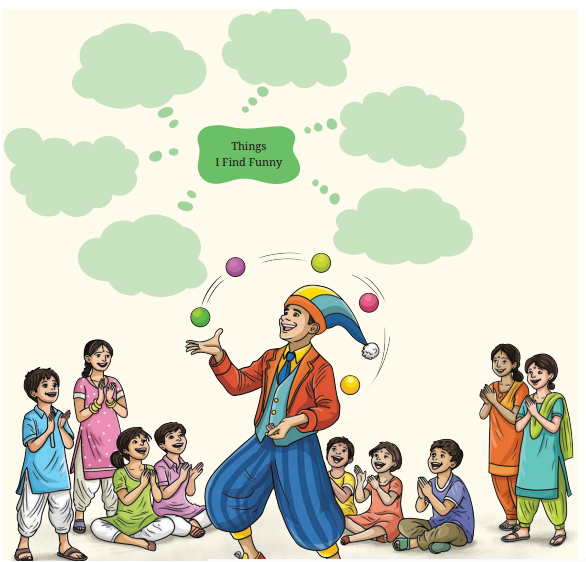
Answer:
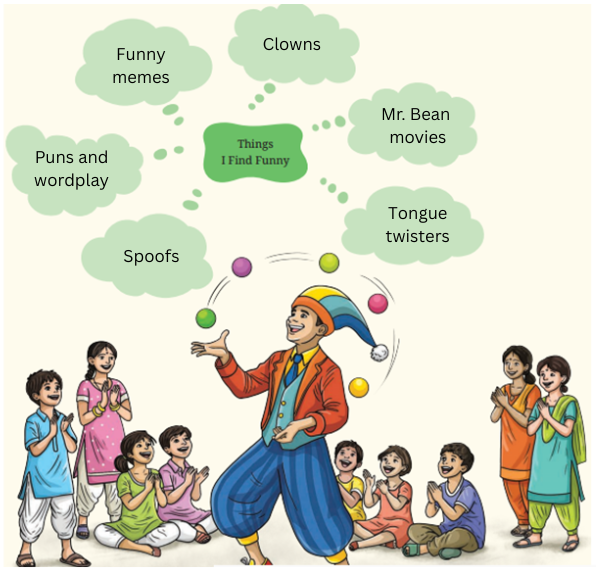
Let us discuss (Page 61)
I. Work in pairs. Identify the true statements. Check your answers with the teacher.
1. The poet says that she had never heard such an amusing song.
2. The funny man was quite ill-mannered.
3. The funny man wore two hats on his feet.
4. The funny man hopped on his head to reach home.
5. The funny man gave a rose to the poet.
6. The funny man smiled at the poet.
Answers:
1. True – “You never heard in all your life / Such a funny feeling sound.” implies it was amusing.
2. False – The man “smiled politely” and was well-mannered.
3. True – “And hats upon his feet.”
4. True – “And hopped home on his head.”
5. False – He gave a currant bun, not a rose.
6. True – “He raised the shoe and smiled at me.”
II. Identify the words from the poem based on the meanings given.
Share your answers with your classmates and the teacher.
1. a small seedless raisin – C __ R __ __ __ T
2. moved unsteadily – S __ __ G G __ __ __ D
Answers:
1. a small seedless raisin – C U R R A N T
2. moved unsteadily – S T A G G E R E D
III. Complete the following sentences with a reason.
1. The tone of the poem is ___________ because ___________.
Answer:
The tone of the poem is playful because it describes the absurd and silly actions of the strange man in a light-hearted and carefree way.
2. The rhyme scheme of the poem is ___________; and it gives a ___________quality to the poem.
Answer:
The rhyme scheme of the poem is ABCB; and it gives whimsical quality to the poem.
3. The poet has frequently repeated the word ‘funny’ in order to ___________.
Answer:
The poet has frequently repeated the word ‘funny’ in order to draw attention to the absurd and ridiculous situation and character.
IV. Choose the correct answer from the options given in the brackets.
1. The poem uses vivid imagery to create a _______________________
(humorous and nonsensical/ confusing but thought-provoking) scene.
2. The structure of the poem is in ___________ (monologue/ dialogue) form.
3. The phrases ‘sounding sight’ and ‘hopped home’ are examples of
___________. (alliteration/simile)
Answers:
1. The poem uses vivid imagery to create a humorous and nonsensical (humorous and nonsensical/ confusing but thought-provoking) scene.
2. The structure of the poem is in dialogue (monologue/ dialogue) form.
3. The phrases ‘sounding sight’ and ‘hopped home’ are examples of alliteration. (alliteration/simile)
V. Rewrite the following line from the poem in the correct order.
1. “But never had I seen before
Such a funny sounding sight.”
Answer:
I had never seen such a funny sounding sight before.
| Sometimes, the poets change the word order (inversion) in a line in order to maintain a rhythm. |
2. Why has the poet used phrases like ‘funny sounding sight’ and ‘funny feeling sound’ with reference to the funny man?
Answer:
The poet uses these phrases deliberately to create incongruity and playful confusion by mixing senses — describing sights in terms of sound, and sound in terms of touch. This highlights the absurd humour of the poem and stresses how bizarre and outlandish the character is.
VI. Can you think of any real-world situations where people do similar things for fun, entertainment, or performance? Share with your classmates and the teacher.
Answer:
People do similar things for fun or performance in real life:
Clowns in circuses dress and behave absurdly to make people laugh.
Street performers and mimes often act in strange, exaggerated ways to make people laugh.
Children’s theatre and puppet shows frequently include nonsensical humour, for example “Punch and Judy”.
People often dress in quirky, unexpected ways for fancy dress parades.
Let us think and reflect (Page 62)
I. Read the extracts given below and answer the questions that follow.
1. He said, “Allow me to present
Your Highness with a rose.”
And taking out a currant bun
He held it to my nose.
I staggered back against the wall
And then I answered, “Well!”
(i) Why does the funny man address the poet as ‘Your Highness’?
Answer:
The funny man addresses the poet as ‘Your Highness’ as part of his absurd and exaggerated act
— treating the poet like royalty adds to the poem’s comic tone.
(ii) Choose a phrase from the extract which indicates a polite request.
Answer:
“Allow me to present”
This is a formal and polite way to offer something.
(iii) Choose the option which shows a ‘currant bun’.

Answer:
B. Image 2 shows a currant bun.
(iv) Complete the sentence with an appropriate reason.
When the poet says, ‘Well!’, it expresses surprise. This was so because _________________.
Answer:
When the poet says, ‘Well!’, it expresses surprise. This was so because she was expecting a sweet smelling rose, but was presented with a currant bun instead which was strange and unexpected.
2. You never heard in all your life Such a funny feeling sound.
“My friend, why do you wear two hats
Upon your feet?” I said.
He turned the other way about,
And hopped home on his head.
(i) Choose the line from the extract which tells us that the sound was unique.
Answer:
“You never heard in all your life / Such a funny feeling sound.”
This line shows that the sound was unique.
(ii) Complete the sentence with an appropriate reason.
The poet calls the funny man ‘my friend’ because _________________.
Answer:
The poet calls the funny man ‘my friend’ because she was amused by his outlandish appearance and quirky behaviour and was eager to get to know him better.
(iii) What does the reaction of the funny man to the poet’s question tell us about him?
Answer:
The reaction of the funny man to the poet’s question tells us that he is unpredictable and whimsical. Instead of answering, he does something even more absurd — hopping away on his head — which reflects his capricious and illogical nature.
(iv) Choose the correct option to complete the sentence.
The last line of the extract makes the readers feel _________________.
A. dreamy B. impatient C. worried D. cheerful
Answer:
The last line of the extract makes the readers feel D. cheerful.
It’s a ludicrous and silly ending that leaves readers laughing or smiling at the man’s bizarre behaviour.
II Answer the following questions. (Page 63)
1. Which character trait of the funny man was most appealing to you? Why?
Answer:
The character trait of the funny man which appealed to me most is his playful and creative nature. He seems to delight in his own unique way of doing things. This makes him unpredictable and interesting.
2. The funny man does unusual things in the poem. How does it affect the overall mood of the poem?
Answer:
The funny man’s unusual actions — like wearing shoes on his head or hopping home — create a light-hearted and comical mood. His ludicrous behaviour fills the poem with surprise and laughter, making it delightful to read.
3. What alternative title would you suggest for the poem? Give reason(s) for your choice.
Answer:
I would suggest “A Rose That Smelled Like Currant Bun” as an alternative title for the poem.
It plays on the on the element of surprise when the man offers the poet a homely currant bun instead of a romantic rose, reflecting the poem’s comical twist.
4. Why do you think the poet has included dialogues in the poem?
Answer:
I think that the poet has included dialogues to add vitality and energy to the poem. The characters’ dialogues reveal more about who they are and add a dramatic element, making the scenes feel livelier and more entertaining.
5. What does the poet wish to convey by highlighting the unusual behaviour of the funny man?
Answer:
By highlighting the unusual behaviour of the funny man, the poet might be suggesting that it’s perfectly fine to be unique or unconventional. The funny man’s actions question what we usually consider “normal” and remind us that imagination, laughter, and friendliness can make life more joyful, even if they appear strange to others.
Let us learn (Page 63)
Read the following phrases from the poem.
• walking down • taking out • sat down
These are phrasal verbs.
| Phrasal verbs are combinations of a verb with a preposition or adverb that together function as a single unit. They often have meanings that are different from the individual words used alone. The same verb followed by different prepositions or adverbs conveys different meanings. |
I. Match the phrasal verbs in Column 1 with their correct meaning in Column 2.
| Column 1 | Column 2 |
| 1. take up | (i) To understand or comprehend something |
| 2. take after | (ii) to assume control or responsibility for something |
| 3. take in | (iii) to begin to study, practice or do something |
| 4. Take over | (iv) to become popular or successful quickly |
| 5. Take off | (v) to resemble or look similar to (Usually a family member) |
Answer:
| Column 1 | Column 2 |
| 1. take up | (iii) to begin to study, practice or do something |
| 2. take after | (v) to resemble or look similar to (Usually a family member) |
| 3. take in | (i) To understand or comprehend something |
| 4. Take over | (ii) to assume control or responsibility for something |
| 5. Take off | (iv) to become popular or successful quickly |
Now, fill in the blanks with suitable phrasal verbs from the table given in I. You may change the tense of the verb, if required.
1. The new technology is set to _________________ traditional methods of communication.
2. I tried hard to _________________ what the writer wanted to say but was unsuccessful.
3. Arjun decided to _________________ painting as a hobby.
4. The smartphone quickly _________________ the sales in the market.
5. Sheela _________________ her father; they have the same smile.
Answer:
1. The new technology is set to take over traditional methods of communication.
2. I tried hard to take in what the writer wanted to say but was unsuccessful.
3. Arjun decided to take up painting as a hobby.
4. The smartphone quickly took off the sales in the market.
5. Sheela takes after her father; they have the same smile.
II Match the verbs in Column 1 with any suitable adverbs or prepositions in Column 2. Write their meanings in Column 3. An example has been done for you.
| Column 1 | Column 2 | Column 3 |
| 1. look | after, away, up, for, in, on, into, down, off, out | Look after: Take care of |
| 2. run | Run down: dilapidated | |
| 3. put | Put up: tolerate | |
| 4. break | Break away: to separate from something or someone | |
| 5. call | Call off: cancel an event or arrangement |
Now, frame sentences of your own using any five phrasal verbs.
Answer:
1. Look after:
Parents look after their children with tender loving care.
2. run down:
The condition of the house was so run down that the municipality decided to demolish it.
3. Put up:
The landlord decided not to put up with the unruly behaviour of his tenant and asked him to vacate the house.
4. break away:
Several members broke away from the political party to form a new one.
5. Call off:
The outdoor concert was called off because of the imminent cyclone.
III. Read the following words from the poem.
walking, staggered, hopped
The given words denote the different ways of walking. Arrange the words given in the box in increasing order of pace.
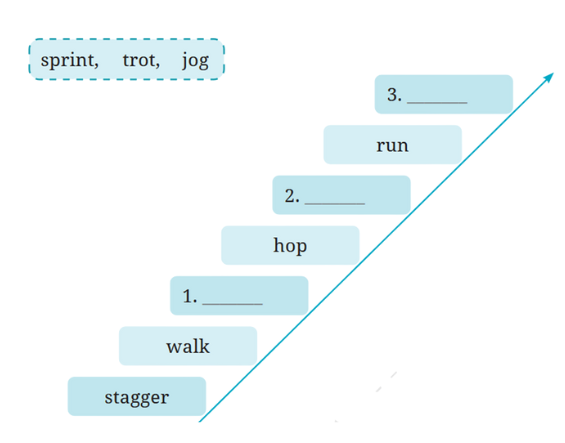
Answer:
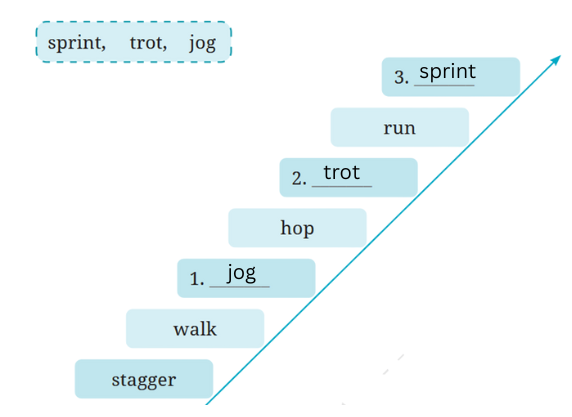
1. jog
2. trot
3. sprint
Let us listen (Page 65)
I. You will listen to a girl narrate a personal incident. As you listen, select the picture related to the narration. (Transcript for the teacher on pg. 88)
Answer:
Picture 3 is related to the narration.
II. You will once again listen to the girl narrate a personal incident. As you listen, arrange the events in order of occurrence.
1. Ate lunch
2. Took off shoes
3. Put shoes in the room
4. Laughed at the mistake
5. Placed the plate in the room
6. Prepared for the presentation
7. Put the plate in the kitchen
Answer:
Here’s the correct order of events from the girl’s narration:
1. Prepared for the presentation
2. Took off shoes
3. Ate lunch
4. Placed the plate in the room (by mistake)
5. Put shoes in the kitchen (instead of the room)
6. Laughed at the mistake
7. Put the plate in the kitchen (corrected it)
Let us speak (Page 6)
Read the joke given below.
A man is talking to God.
The man says, “God, how long is a million years?”
God replies, “For me, it’s about a minute.”
The man asks, “How much is a million rupees?”
God smiles and replies, “It’s less than a rupee for me.”
The man quickly requests, “God, may I have a rupee?”
God promptly says, “Wait a minute.”
Work in pairs and take turns to tell the joke.
Remember:
• Narrator’s voice – your own voice (speak in a matter-of-fact manner)
• Man’s voice – change to louder voice (speak with respect)
• God’s voice – deep voice (speak in a pleasant tone)
Now, work in pairs to create a joke and tell it in front of the class
Answer:
Have fun rehearsing and presenting the joke in front of your teacher and classmates.
Let us write (Page 66)
I. A limerick is a nonsensical and funny verse consisting of five lines.
Study the limerick given below and identify the rhyme scheme.
1. There was an Old Man with a beard,
Who said, “It is just as I feared!
Two Owls and a Hen,
Four Larks and a Wren,
Have all built their nests in my beard!”
Edward Lear
Answer:
The rhyme scheme of the limerick is AABBA
Now, read another limerick
2. There were two friends in Bengaluru’s lanes,
One loved books, the other flew planes.
They’d laugh and they’d play,
In their own unique way,
Creating stories and flying in dreams’ trains.
Remember all limericks have the same rhyme scheme AABBA.
II Follow the structure given below and write a limerick on your own.
Line 1: Introduction of a person or place
There was a child from ___________
Lines 2-4: A silly story
Who ___________
She/He ___________
Line 5: An unexpected ending ______
Answer:
There was a child from Mumbai
Who to reach the sky would try
She bounced on her bed
On the ceiling knocked her head
Then laughed and cried “I can fly!”
Let us explore (Page 67)
I. In ancient Indian literature and mythology, there are several humorous or funny characters who play important roles in the stories. These characters often represent wit, humour and mischief while conveying deeper moral lessons. Here are a few well-known funny characters:

Take any story to read and share it with your classmates and the teacher.
Answer:
Here’s a short and funny Mullah Nasruddin story you can read aloud or share with your classmates and teacher:
Mullah Nasruddin and the Lost Ring
One day, Mullah Nasruddin was crawling around on his hands and knees under a streetlamp.
A friend saw him and asked, “Mullah, what are you doing?”
Nasruddin replied, “I’m looking for my ring. I lost it!”
The friend joined him and they both searched carefully.
After some time, the friend asked, “Where exactly did you lose it?”
Nasruddin calmly replied, “Oh, I lost it inside my house.”
The friend was shocked. “Then why are you searching out here?”
Nasruddin said, “Because it’s brighter out here under the streetlamp!”
Moral of the story:
Sometimes, people look for answers where it’s easy, not where the real solution lies.
II. We can identify the acts of the funny man with certain modern – day activities that have playfulness, or unconventional behaviour.
Answer:
Modern-Day Parallels to the Funny Man’s Actions
The funny man’s unconventional behaviour in the poem mirrors several modern forms of playful entertainment:
Street Performers & Clowns
– Like the funny man, they dress in quirky ways, do unexpected acts, and use humour to engage people.
Performance Art or Abstract Theatre
– The funny man’s odd gestures and singing resemble performance artists who break traditional rules to create fascinating and stimulating moments.
Children’s Entertainment & Comedy Shows
– The funny man’s antics are similar to characters in kids’ shows, who use outrageous actions and amusing dialogues to make children laugh.
Common Thread:
These activities, like the poem, are very creative, humorous, and rely on the absurdity. They challenge our sense of logic and inspire us to discover the thrill of being different—just like the funny man.
III. Sukumar Ray, an Indian poet and illustrator, wrote poems in a similar style in his book Abol Tabol. You may also share a similar poem from your native language with your classmates and the teacher.
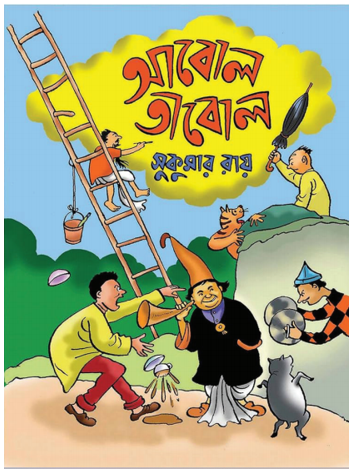
Answer:
Here is a poem from Abol Tabol translated from Bengali to English which you can share with your classmates and teacher.
Baburam the Snake Charmer
Hullo, there Baburam – what have you got in there?
Snakes? Aha – and do you think there’s one that you could spare?
You know, I’d love to have one, but let me tell you this –
The ones that bite aren’t right for me – nor the ones that hiss.
I’d also skip the ones that butt
As well the ones that whistle
Or the ones that slink about
Or show their fangs, or bristle.
As for eating habits, I think it would be nice
To go for ones that only take a meal of milk and rice.
I’m sure you know the kind of snake that I want from what I’ve said,
Do let me have one, Baburam, so I could bash its head.
— Translated by Satyajit Ray
Hope you found our solutions to NCERT Class 7 English Poorvi Wit and Humour Chapter 5 ‘A Funny Man’ helpful! Need extra help? Book a free demo class now!


